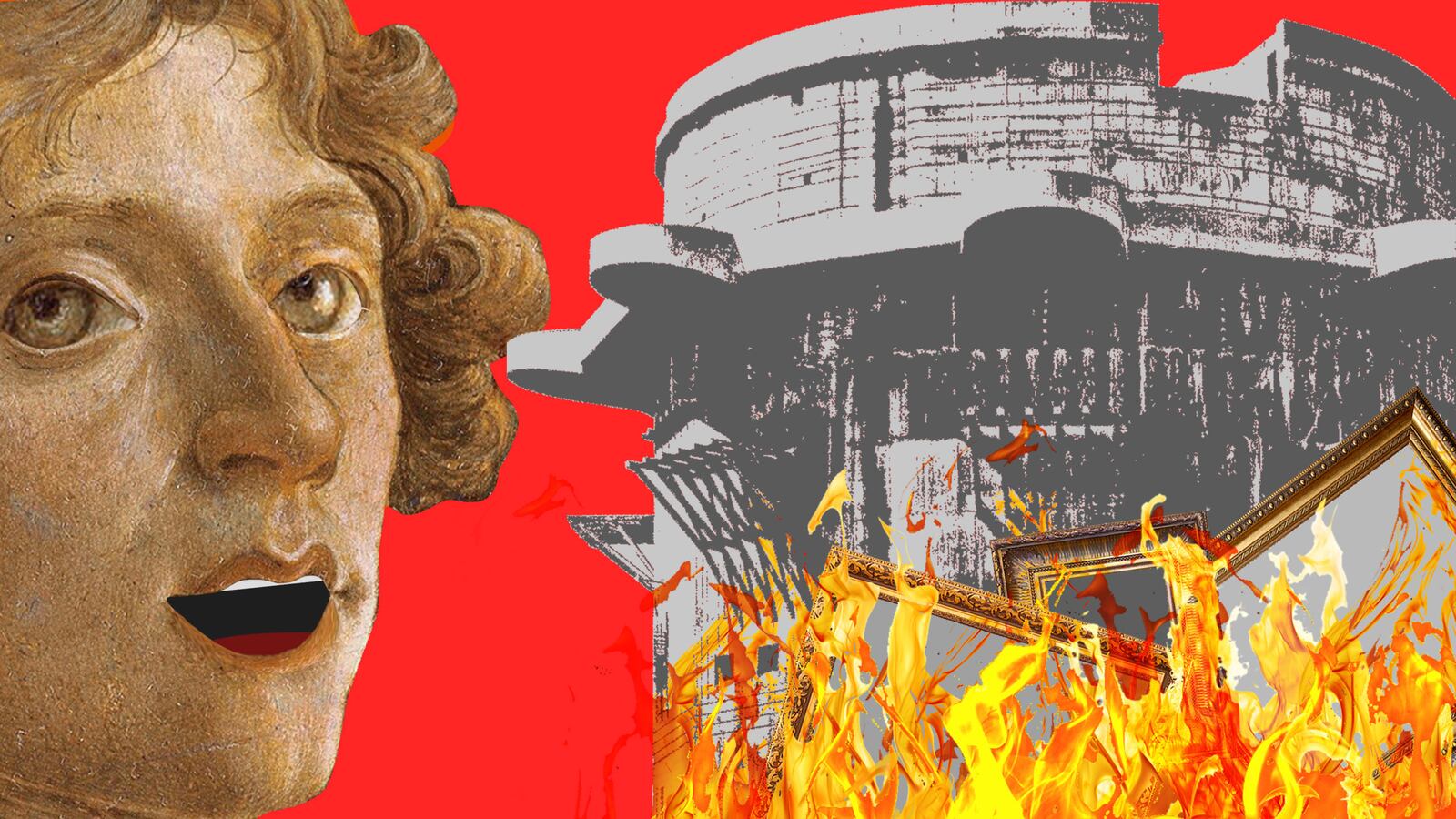Botticelli may be best known for two of his mythological works—The Birth of Venus and La Primavera—but religious paintings occupied just as much of the artistic attention of the 15th-century Florentine Renaissance master.
When he wasn’t making portraits for the elite or salacious paintings for the bedrooms of the Medici’s, Botticelli was mixing his oils and wielding his brushes to perfect his Madonna and Child compositions.
He made altarpieces for churches and painted famous nativity scenes (the leading figures of Florence made an appearance in Baby Jesus’ adoring crowd, of course). And he was called on to complete frescos to decorate one wall of the Sistine Chapel.
But Botticelli wasn’t just showing off his prowess in one of the biggest genres of the day; he was a true believer whose religious fervor reached a peak in the late 1400s when he became a follower of the fanatic friar Girolamo Savonarola.
In 1497, Savonarola staged a real-life bonfire of the vanities in Florence in which he called on residents to rid themselves of all sinful objects that distracted from their religious devotion.
Many believe that the fancy clothing, books, and other objects of earthly finery were joined in the blaze by some of Botticelli’s non-religious works contributed by the artist himself.
Botticelli’s religious paintings may have escaped that famous Florentine fire on Feb. 7, 1497, but three of his spiritual works might not have been so lucky over four centuries later.
As the Soviets invaded Berlin in early May 1945, the site in which Botticelli’s Madonna and Child with Angels Carrying Candlesticks, Annunciation, and Madonna and Child with Little Saint John were being held for safe-keeping suffered two separate fires. When the smoke cleared, over 700 works of art by some of the world’s greatest masters were gone.
World War II may have sent a tidal wave of death and destruction across the continent of Europe and beyond, but the struggle for power didn’t just occur on the battlefield.
“Art was central to both Hitler’s and Stalin’s Weltanschauung [world view],” Klaus Goldmann, chief curator of Berlin's Museum for Prehistory and Early History told Newsweek in 1991. “The Nazis and Soviets went at it with equal vigor on the theory that if you destroy a people’s art, then you destroy their historical identity and confidence. It wasn’t just a matter of some GI stuffing things into his pockets. We are talking about confiscation of art as a matter of state policy.”
The Germans excelled in artistic plunder, but when the tide of victory began to turn, they found themselves scrambling to safeguard their own treasures, both those legitimately acquired and those obtained by nefarious means.
Starting in 1940, the Allies turned their sights on Berlin.
According to Race for the Reichstag by Tony Le Tissier, the capital of the Third Reich suffered 450 bombing raids during which 45,517 tons of bombs and mines rained down on the city.
In response to this barrage, Hitler ordered the construction of three flak towers in Berlin. These massive towers “were veritable fortresses, being both bomb-proof and shell-proof, with walls six feet thick and heavy steel doors over all the apertures,” according to Le Tissier.
They served two purposes: They were a bunker for civilians, military personnel, and the city’s treasures to escape the constant Allied bombardment; and they were a giant platform on which the Nazi army could install anti-aircraft missiles to aid in the defense of the city.
One of these towers, Flakturm Friedrichshain, was the evacuation site for what was then the Kaiser Friedrich Museum (known today as the Bode Museum).
The museum’s greatest works of painting and sculpture were removed from their galleries and stored in this bunker for safe keeping. Among the trove of Renaissance masterpieces were works by Caravaggio, Donatello, Rubens, Fra Angelico, and the three early Botticelli paintings.
In early May 1945, not only did the Soviets attack the city in an attempt to end the Second World War, but they also snatched up any works of art that they could get their hands on, in the end taking around 2 million objects worth billions of dollars.
The towers were meant to be impenetrable fortresses, but Flakturm Friedrichshain experienced a bout of bad luck during the invasion. Here the record gets a little murky as both sides point a finger at the other, but the result was the same. In the first days of May, a fire broke out in the tower. It was eventually put out, but several days later, a second and larger fire broke out. In the end, three floors of the tower being used by the museum had been scorched and their contents believed destroyed.
It was a heartbreaking loss, and not just for the Germans. It is estimated that over 400 paintings and 300 sculptures which represented “most significant works from what was one of the most impressive and valuable art collections in Europe” were lost.
The head of the Soviet’s Berlin trophy brigade, Andre Belokopitov, visited the site shortly after the second fire was extinguished and reported on the aftermath of the blaze.
“As he opened a heavy metal door, the marble statues began to fall apart and vaporized in front of him. When marble is exposed to extreme heat in the absence of oxygen, it is transformed into lime so when he opened the door and let oxygen in, the exchange of gases caused the statues to disintegrate,” Ivan Lindsay wrote in The History of Loot and Stolen Art. “Belokopitov was the last human to see those sculptures intact.”
Or was he?
The fires have always been shrouded in suspicion. It is known that the Soviets raided what was left after the inferno died down, but some believe they were involved well before that.
Whether they were responsible for starting the fire to cover up the treasures they had taken or whether they had an opportunity to nab some of the masterpieces before the second fire struck, many think that at least some of the 700 works of art and sculpture believed to have perished over those few fiery days may not really be destroyed after all.
“The Soviets blamed Nazi diehards, but many experts now believe the fire was set by the Soviets themselves, and that the paintings were removed first,” reads the 1991 Newsweek article. “Works brought back to the Soviet Union were stuffed into museum warehouses, where they remain today.”
Over the years, bits and pieces of evidence have surfaced that give credence to these suspicions. In 2011, for instance, a painting surfaced at auction that was part of the collection believed burned to cinders.
According to a report in The New York Post, the owner had inherited the piece from his father, who was stationed in Berlin during the war and who is believed to have bought the painting from “a street vendor or a Russian soldier.”
These days, Botticelli’s religious works not only represent some of his top selling pieces at auction, but in 2013, the artist’s painting known as the Rockefeller Madonna sold for $10.4 million.
With at least one painting having survived the Berlin blaze, there’s hope that others did as well—and maybe Botticelli’s three early religious works are among them.






